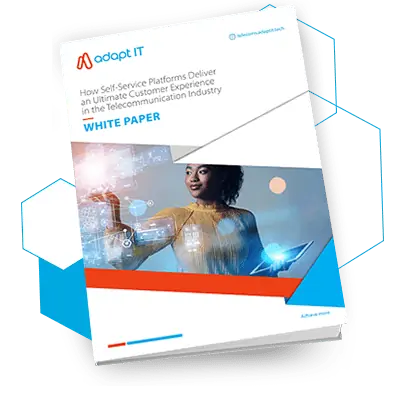Today’s telecommunications landscape is rapidly evolving, and integrating Artificial Intelligence (AI) and Machine Learning (ML) technologies has become critical to the success of Telcos. As more and more consumers demand seamless connectivity, enhanced user experiences, and optimised network performance, Telcos are turning to AI and ML technologies to make this possible. The blog below highlights how AI and ML technologies are fast becoming the cornerstone for innovation, efficiency, and competitiveness in the telecommunications sector.
Table of Contents
ToggleUnderstanding AI and ML
To understand how AI and ML technologies enhance offerings and maximise operations, it is essential to understand what these technologies do.
In simple terms, Artificial Intelligence (AI) is the simulation of human intelligence in machines or computer systems that can perform tasks that typically require human intelligence. These tasks include problem-solving, learning from experience, understanding natural language, recognising patterns, and making decisions. AI systems use algorithms and data to process information, make predictions, and adapt to new information or changing circumstances. Machine Learning (ML) is a subset of AI involving training algorithms that recognise patterns and make predictions.
Artificial Intelligence (AI) and Machine Learning (ML) have become integral components across various industries, transforming businesses’ operations and providing innovative solutions to complex problems. Here are some key capabilities and applications of AI and ML across different sectors:
- Healthcare – AI technology can be used to analyse medical images, such as X-rays and MRIs, to aid in disease detection. ML algorithms can predict patient outcomes and help in preventive care. AI is also being used to accelerate the drug discovery process by analysing biological data for new medical drugs.
- Finance – ML algorithms are being used for fraud detection and can be used to identify patterns indicative of fraudulent activities in near real-time. AI is being used to enable automated trading strategies based on historical data and market trends, and ML models can assess creditworthiness by analysing customer data.
- Manufacturing – ML algorithms can predict equipment failures, reducing downtime and maintenance costs, while AI systems can identify defects in near real-time during the manufacturing process. AI is also being used to optimise supply chain processes, improving efficiency and reducing costs.
- Agriculture – AI can analyse data from sensors and satellites to optimise farming practices. ML algorithms are used to assess crop health and predict potential diseases, while AI-powered robots perform planting, harvesting, and weeding tasks.
The applications of AI and ML are continually expanding across these industries, contributing to increased efficiency, cost savings and better decision-making. Now, let’s look at how AI and ML technologies are being utilised in the telecommunications sector.

AI and ML applications in Telecoms
AI and ML technologies allow for the analysis of vast volumes of data, which are used to predict network issues, automated processes, and customised services, ultimately enabling Telcos to deliver more efficient, reliable, and personalised services to their customers. We unpack how these technologies are being utilised for each of the Telco business components below:
Enhancing Customer Offerings
AI and ML are revolutionising customer experiences by enabling personalised interactions and services. These technologies utilise and analyse large volumes of data to understand individual preferences and behaviours, enabling Telcos to provide tailored marketing campaigns, offerings and services. Advanced ML algorithms analyse historical data, user interactions, and demographics to predict and suggest products, services, or content that align with customer interests. This not only enhances user engagement but also increases customer satisfaction and loyalty.
AI and ML play a crucial role in improving customer service. AI-powered chatbots can deliver instant and personalised responses to customer inquiries, efficiently addressing their concerns. These systems continuously learn and adapt, refining their ability to understand and respond to customer queries over time. The use of these technologies streamlines the support process and ensures consistency and accuracy in meeting customer service needs.
In this way, AI and ML enable Telcos to move beyond generic approaches and deliver personalised and customised experiences that cater to each customer’s unique preferences and needs.
Optimising Operational Efficiency
Telcos are using AI and ML technologies to streamline operations, optimise network management, and reduce costs. Telcos can automate repetitive tasks like network monitoring and troubleshooting using AI and ML algorithms. This results in quicker identification and resolution of common issues, minimising downtime and improving network efficiency.
ML algorithms also can analyse large amounts of data to predict network congestion, identify potential failures, and optimise resource allocation. This predictive capability allows Telcos to proactively tackle issues before they become problems, leading to a more reliable and stable network. As a result, operational costs are significantly reduced as manual intervention is minimised. Automating routine tasks not only enhances the speed and accuracy of network management but frees up human resources to focus on more strategic and innovative activities.
Data-Driven Insights and Decision-Making
These innovative technologies are essential in extracting valuable insights from Telco networks’ large volumes of data and information. By utilising the capabilities of AI and ML algorithms, Telcos can make business decisions based on data related to network performance and customer experiences. These technologies enable the analysis of complex patterns and trends within massive datasets, empowering Telcos to optimise their network infrastructure, predict potential bottlenecks, and effectively address any issues before they can negatively impact the quality of service and revenue.
The seamless integration of AI and ML in the telecommunications industry improves operational efficiency. It allows Telcos to remain adaptable and responsive in a rapidly evolving industry, but what are the challenges and ethical considerations of deploying this technology?
Challenges and Ethical Considerations
From the above, it is clear that the integration of AI and ML in the telecommunications industry has revolutionised operations, bringing significant efficiency and capabilities. There are, however, several challenges and ethical concerns that come with implementing this technology.
Telcos handle large amounts of sensitive customer data, and using AI algorithms raises concerns regarding the security and confidentiality of this information. There is also a potential risk of bias in AI models, which can highlight inequalities in areas like customer service or resource allocation.
To address these issues, the Telcos must prioritise the responsible implementation of AI. This includes adopting transparent and explainable AI systems, ensuring compliance with data protection regulations, and actively addressing algorithm bias. Ethical considerations should be integral to AI development, deployment, and ongoing management.
Ultimately, the responsible use of AI in the telecom sector not only protects individuals’ privacy and rights but also builds trust among consumers, laying the groundwork for sustainable and socially responsible technological advancement.
5G Integration with AI and ML
As there are various challenges related to these technologies, there are also more innovations and opportunities to improve how these technologies work. AI and ML are set to have a significant impact on 5G and optimising these networks.
The introduction of 5G technology marks a new era in connectivity with promises of faster data speeds, reduced latency, and increased capacity. AI and ML are vital for optimising 5G networks as they offer solutions to improve efficiency and address network complexities. Key to this is network slicing, an essential feature of 5G that enables the creation of virtualised and isolated network segments customised for specific applications or services. Real-time data is utilised by AI and ML algorithms to dynamically manage and optimise these slices, ensuring the best allocation of resources and performance.
AI and ML technologies can also significantly enhance the security of 5G networks. These networks’ increased complexity and scale make them more vulnerable to cyber threats. AI-powered security systems continuously analyse network traffic patterns, detect anomalies, and identify potential security breaches in real-time. These systems adapt and evolve to emerging threats through machine learning, providing a proactive defence mechanism against cyber-attacks. AI-driven predictive analytics can also identify potential vulnerabilities and offer pre-emptive measures, thereby improving the overall security of 5G networks.
As 5G continues to be rolled out globally, the integration of AI and ML will be fundamental in unlocking the full potential of this network and ensuring a seamless and secure connectivity experience for users globally.

Conclusion
Integrating AI and ML technologies in the telecommunications industry has significantly affected efficiency, innovation, and enhanced customer experiences. By harnessing the power of these advanced technologies, Telcos can optimise their operations, predict network issues before they arise, and deliver tailored services that meet the evolving demands of consumers. For AI and ML technologies to be successful, it is vital to ensure various ethical and data privacy considerations are in place. The value of AL and ML technologies within the telecommunications industry is only starting to reveal itself, and as the use of the 5G network continues to increase, this technology’s role is set to expand. This is an exciting space to watch.
Explore the Power of CDR

As the Product Manager of Advanced Analytics within the Adapt IT Telecoms division, I bring 16 years of Telecommunications expertise to the table. Over the past 8 years, my focus has been on Product Development. My responsibilities encompass identifying customer needs, monitoring industry trends, and driving our Advanced Analytics strategy. I’m deeply passionate about leveraging big data for analytical insights and product evolution through machine learning and AI. My experience extends to Mobile Network Events, Mobile Financial Services, and supplementary services.





